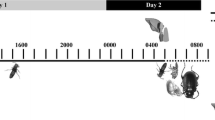Abstract
Field observations of flowering Alisma plantago-aquatica plants were carried out in Moscow region (Russia). The A. plantago-aquatica flower remains anthetic for a single light day, from 9:00 a.m. to 8:00 p.m. White petals showed a contrast bicolored pattern in UV light, and the pattern probably serves as a nectar clue for pollinators. Flowers were visited by insects in daytime from 11:00 a.m. to 3:00 p.m. Coleopterans (Coccinellidae), dipterans (Drosophilidae, Hybotidae, Muscidae, Sepsidae, and Syrphidae), and hymenopterans (Apidae) were observed as flower visitors. Hoverflies (Syrphidae) and bees (Apidae) were the most frequent visitors. Large amounts of A. plantago-aquatica pollen grains were found on their bodies, and a major role in pollination was consequently assumed for the insects. Based on the original findings and literature data on A. plantago-aquatica reproductive biology in Belgium, Slovakia, and the Czech Republic, hoverflies were identified as the most stable and efficient pollinators of A. plantago-aquatica in various parts of the species range. Bees (Apidae) were recognized as A. plantago-aquatica pollinators for the first time in this work. A flower isolation experiment confirmed that A. plantago-aquatica is a self-compatible plant, but requires insects for the most efficient cross-pollination.






Similar content being viewed by others
REFERENCES
Araki, K., Yamada, E., and Ohara, M., Breeding system and floral visitors of Convallaria keiskei, Plant Species Biol., 2005, vol. 20, pp. 149–153.
Charlton, W.A., Studies in the Alismataceae, II: Inflorescences of Alismataceae, Can. J. Bot., 1973, vol. 51, no. 4, pp. 775–789.
Chen, L.Y., Chen, J.M., Gituru, R.W., Temam, T.D., and Wang, Q.F., Generic phylogeny and historical biogeography of Alismataceae, inferred from multiple DNA sequences, Mol. Phylogenet. Evol., 2012, vol. 63, no. 2, pp. 407–416.
Daumann, E., Insekten- und Windbestäubung bei Alisma plantago-aquatica L., Österreichische Bot. Z., 1965.
Daumann, E., Zur Morphologie der Blüte von Alisma plantago-aquatica L., Preslia, 1964, vol. 36, no. 3, pp. 226–239.
Dixon, T.A., Studies on oviposition behaviour of Syrphidae (Diptera), Trans. R. Entomol. Soc. London, 1959, vol. 111, pp. 37–81.
Eber, E., Karpellbau und Plazentationsverhältnisse in der Reihe der Helobiae: Mit einem Anhang über die verwandtschaftlichen Beziehungen zwischen Ranales und Helobiae, Flora Allg. Bot. Ztg., 1934, vol. 127, no. 4, pp. 273–330.
Haynes, R.R., Les, D.H., and Holm-Nielsen, L.B., Alismataceae, in Flowering Plants. Monocotyledons, Berlin Heidelberg, 1998, pp. 11–18.
Igersheim, A., Buzgo, M., and Endress, P.K., Gynoecium diversity and systematics in basal monocots, Bot. J. Linn. Soc., 2001, vol. 136, no. 1, pp. 1–65.
Iwamoto, A., Nakamura, A., Kurihara, S., Otani, A., and De Craene, L.P.R., Floral development of petaloid Alismatales as an insight into the origin of the trimerous Bauplan in monocot flowers, J. Plant Res., 2018, vol. 131, no. 3, pp. 395–407.
Jacobson, A. and Hedren, M., Phylogenetic relationships in Alisma (Alismataceae) based on RAPDs, and sequence data from ITS and trnL., Plant Syst. Evol., 2007, vol. 265, no. 1, pp. 27–44.
Kamelina, O.P., Sistematicheskaya embriologiya tsvetkovyh rastenii. Odnodolnye (Systematic Embryology of Flowering Plants. Monocots), Barnaul, 2011.
Kaul, R.B., Reproductive phenology and biology in annual and perennial Alismataceae, Aquat. Bot., 1985, vol. 22, no. 2, pp. 153–164.
Remizowa, M.V., Sokoloff, D.D., and Rudall, P.J., Evolutionary history of the monocot flower, Ann. Mo. Bot. Gard., 2010, vol. 97, no. 4, pp. 617–645.
Singh, V. and Sattler, R., Floral development of Alisma triviale, Can. J. Bot., 1972, vol. 50, no. 3, pp. 619–627.
Sokoloff, D.D., von Mering, S., and Remizowa, M.V., Female flower and fruit anatomy of Tetroncium magellanicum: implications for gynoecium evolution in the early divergent monocot order Alismatales, Bot. J. Linn. Soc., 2015, vol. 179, no. 4, pp. 712–724.
Thijs, K.W., Brys, R., Verboven, H.A., and Hermy, M., The influence of an invasive plant species on the pollination success and reproductive output of three riparian plant species, Biol. Invasions, 2012, vol. 14, no. 2, pp. 355–365.
Tsvelev, N.N. and Alisma L., in Flora evropeiskoi chasti SSSR (Flora of European Part of USSR), Leningrad, 1979, vol. IV, pp. 158–162.
Tsvelev, N.N., Family Alismataceae, in Zhizn’ rastenii, T. 6. Tsvetkovye rasteniya (Life of Plants, Vol. 6: Flowering Plants), 1981, Moscow, pp. 12–17.
Van Heel, W.A., On the development of some gynoecia with septal nectaries, Blumea, 1988, vol. 33, no. 2, pp. 477–504.
Vieira, M.F. and de Souza Lima, N.A., Pollination of Echinodorus grandiflorus (Alismataceae), Aquat. Bot., 1997, vol. 58, no. 2, pp. 89–98.
Vuille, F.L., Reproductive biology of the genus Damasonium (Alismataceae), Plant Syst. Evol., 1987, vol. 157, no. 1, pp. 63–71.
Vuille, F.L., The reproductive biology of the genus Baldellia (Alismataceae), Plant Syst. Evol., 1988, vol. 159, no. 3, pp. 173–183.
ACKNOWLEDGMENTS
We are grateful to D.D. Sokolov for valuable advice on field experiments and manuscript preparation.
Funding
This work was supported by the Russian Science Foundation (project no. 19-14-00055).
Author information
Authors and Affiliations
Corresponding authors
Ethics declarations
Conflict of interests. The authors declare that they have no conflict of interest.
This article does not contain any studies involving animals or human subjects performed by any of the authors.
Additional information
Translated by T. Tkacheva
Rights and permissions
About this article
Cite this article
Vislobokov, N.A., Kuzmicheva, E.A. Flowering Biology of Alisma plantago-aquatica (Alismataceae). Dokl Biol Sci 506, 172–178 (2022). https://doi.org/10.1134/S0012496622050167
Received:
Revised:
Accepted:
Published:
Issue Date:
DOI: https://doi.org/10.1134/S0012496622050167




